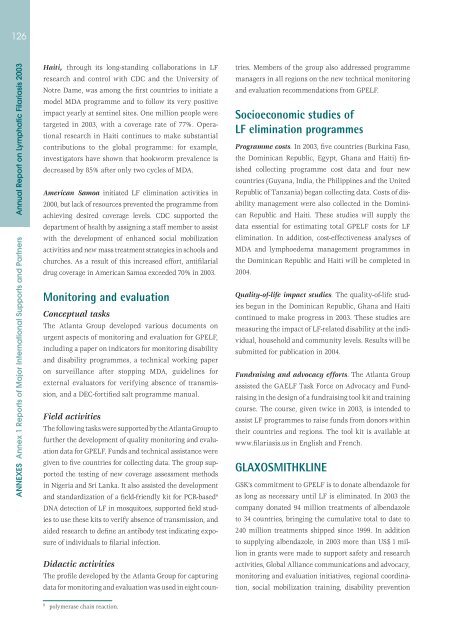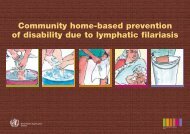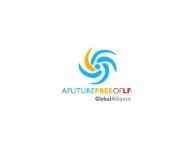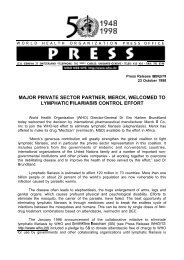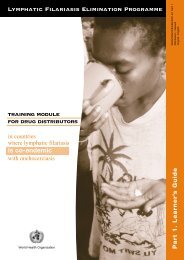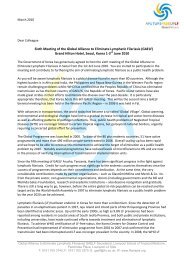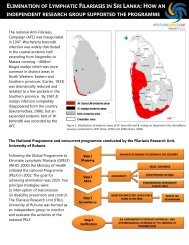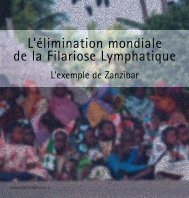Global Programme to Eliminate Lymphatic Filariasis ... - libdoc.who.int
Global Programme to Eliminate Lymphatic Filariasis ... - libdoc.who.int
Global Programme to Eliminate Lymphatic Filariasis ... - libdoc.who.int
You also want an ePaper? Increase the reach of your titles
YUMPU automatically turns print PDFs into web optimized ePapers that Google loves.
126Annual Report on <strong>Lymphatic</strong> <strong>Filariasis</strong> 2003ANNEXES Annex 1 Reports of Major International Supports and PartnersHaiti, through its long-standing collaborations in LFresearch and control with CDC and the University ofNotre Dame, was among the first countries <strong>to</strong> initiate amodel MDA programme and <strong>to</strong> follow its very positiveimpact yearly at sentinel sites. One million people weretargeted in 2003, with a coverage rate of 77%. Operationalresearch in Haiti continues <strong>to</strong> make substantialcontributions <strong>to</strong> the global programme: for example,investiga<strong>to</strong>rs have shown that hookworm prevalence isdecreased by 85% after only two cycles of MDA.American Samoa initiated LF elimination activities in2000, but lack of resources prevented the programme fromachieving desired coverage levels. CDC supported thedepartment of health by assigning a staff member <strong>to</strong> assistwith the development of enhanced social mobilizationactivities and new mass treatment strategies in schools andchurches. As a result of this increased effort, antifilarialdrug coverage in American Samoa exceeded 70% in 2003.Moni<strong>to</strong>ring and evaluationConceptual tasksThe Atlanta Group developed various documents onurgent aspects of moni<strong>to</strong>ring and evaluation for GPELF,including a paper on indica<strong>to</strong>rs for moni<strong>to</strong>ring disabilityand disability programmes, a technical working paperon surveillance after s<strong>to</strong>pping MDA, guidelines forexternal evalua<strong>to</strong>rs for verifying absence of transmission,and a DEC-fortified salt programme manual.Field activitiesThe following tasks were supported by the Atlanta Group <strong>to</strong>further the development of quality moni<strong>to</strong>ring and evaluationdata for GPELF. Funds and technical assistance weregiven <strong>to</strong> five countries for collecting data. The group supportedthe testing of new coverage assessment methodsin Nigeria and Sri Lanka. It also assisted the developmentand standardization of a field-friendly kit for PCR-based 9DNA detection of LF in mosqui<strong>to</strong>es, supported field studies<strong>to</strong> use these kits <strong>to</strong> verify absence of transmission, andaided research <strong>to</strong> define an antibody test indicating exposureof individuals <strong>to</strong> filarial infection.Didactic activitiesThe profile developed by the Atlanta Group for capturingdata for moni<strong>to</strong>ring and evaluation was used in eight countries.Members of the group also addressed programmemanagers in all regions on the new technical moni<strong>to</strong>ringand evaluation recommendations from GPELF.Socioeconomic studies ofLF elimination programmes<strong>Programme</strong> costs. In 2003, five countries (Burkina Faso,the Dominican Republic, Egypt, Ghana and Haiti) finishedcollecting programme cost data and four newcountries (Guyana, India, the Philippines and the UnitedRepublic of Tanzania) began collecting data. Costs of disabilitymanagement were also collected in the DominicanRepublic and Haiti. These studies will supply thedata essential for estimating <strong>to</strong>tal GPELF costs for LFelimination. In addition, cost-effectiveness analyses ofMDA and lymphoedema management programmes <strong>int</strong>he Dominican Republic and Haiti will be completed in2004.Quality-of-life impact studies. The quality-of-life studiesbegun in the Dominican Republic, Ghana and Haiticontinued <strong>to</strong> make progress in 2003. These studies aremeasuring the impact of LF-related disability at the individual,household and community levels. Results will besubmitted for publication in 2004.Fundraising and advocacy efforts. The Atlanta Groupassisted the GAELF Task Force on Advocacy and Fundraisingin the design of a fundraising <strong>to</strong>ol kit and trainingcourse. The course, given twice in 2003, is <strong>int</strong>ended <strong>to</strong>assist LF programmes <strong>to</strong> raise funds from donors with<strong>int</strong>heir countries and regions. The <strong>to</strong>ol kit is available atwww.filariasis.us in English and French.GLAXOSMITHKLINEGSK’s commitment <strong>to</strong> GPELF is <strong>to</strong> donate albendazole foras long as necessary until LF is eliminated. In 2003 thecompany donated 94 million treatments of albendazole<strong>to</strong> 34 countries, bringing the cumulative <strong>to</strong>tal <strong>to</strong> date <strong>to</strong>240 million treatments shipped since 1999. In addition<strong>to</strong> supplying albendazole, in 2003 more than US$ 1 millionin grants were made <strong>to</strong> support safety and researchactivities, <strong>Global</strong> Alliance communications and advocacy,moni<strong>to</strong>ring and evaluation initiatives, regional coordination,social mobilization training, disability prevention9polymerase chain reaction.


